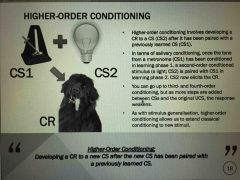![]()
![]()
![]()
Use LEFT and RIGHT arrow keys to navigate between flashcards;
Use UP and DOWN arrow keys to flip the card;
H to show hint;
A reads text to speech;
35 Cards in this Set
- Front
- Back
|
Ivan Pavlov is famous for his idea of |
Classical conditioning |
|
|
Give three phases of classical conditioning |
Acquisition, extinction, spontaneous recovery |
|
|
"The process by which we respond less strongly over time to repeated stimuli" |
Habituation |
|
|
Responding more strongly to repeated stimuli over time |
Sensitisation |
|
|
Classical conditioning is |
A form of learning in which animals come to respond to a previously neutral stimulus that had been paired with another stimulus that elicits an automatic response |
|
|
Stimulus that does not instinctually elicit a response from the organism |
Conditioned stimulus |
|
|
Unconditioned stimulus |
Stimulus that instinctually elicit an automatic, reflexive response from the organism |
|
|
An automatic response to a non-neutral stimulus |
Unconditioned response |
|
|
Each pairing of CS and UCS is called |
Trial |
|
|
Conditioned response (CR) is |
Response that was previously associated with a non-neutral stimulus that is now elicited by a neutral stimulus (CS) |
|
|
The phase of learning by pairing CS and UCS |
Acquisition |
|
|
What is temporal contiguity? |
How close in time the CS and UCS are paired together |
|
|
When UCS comes before CS, this is called |
Backward conditioning |
|
|
As CS and UCS are presented closer in time, the faster/slower learning occurs? |
Faster |
|
|
Extinction is ? |
A phase where CR is reduced and eventually eliminated when CS is given without UCS |
|
|
When extinct CR re emerges after a delay if the CS is presented again |
Spontaneous recovery |
|
|
When stimuli similar to CS produce CR |
Stimulus generalisation |
|
|
When a weaker CR is shown to stimulus different to original CS |
Stimulus discrimination |
|
|
What is higher-order conditioning? |

|
|
|
The difficulty in classical conditioning to a CS we have repeatedly experienced without the UCS ( |
Latent inhibition |
|
|
"The process of acquiring through experience, new and relatively enduring information or behaviors" This is a definition of ? |
Learning |
|
|
A type of learning in which behavior is strengthened if followed by a reinforcer or diminished if followed by punisher |
Operant conditioning |
|
|
➕ reinforcement |
Stimulus that ⬆️ response |
|
|
What does operant conditioning behavior called ? |
Shaping |
|
|
➖ reinforcement |
Removing stimulus to ⬆️ response |
|
|
⬇️ behavior either negatively or positively |
Punishment |
|
|
Primary reinforcer is |
An innately reinforcing stimulus (satisfy biological need) |
|
|
Conditioned reinforcer is |
A stimulus that gains its reinforcing power through its association with primary reinforcer |
|
|
Partial reinforcement is |
Reinforcing a response only part of the time |
|
|
Partial reinforcement is |
Reinforcing a response only part of the time |
|
|
✅ much greater resistance to extinction ❎ slower acquisition process |
Partial reinforcement |
|
|
The Bobo beat down experiment by Albert Bandura explains |
Observational learning |
|
|
All associations are learned equally ( true/false ) ? |
False. Species can more easily learn associations that help them thrive or survive ( animals may differ to one another and different from human) |
|
|
There are two types of learning which are
A) associative and observational B) associative and repeated approach C) kinesthetics and behavorial repetition D) observational and automatic |
A) associative (classical and operant conditioning) and observational (Bobo exp) |
|
|
The process of observing and imitating a specific behavior |
Modelling |

